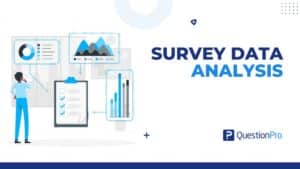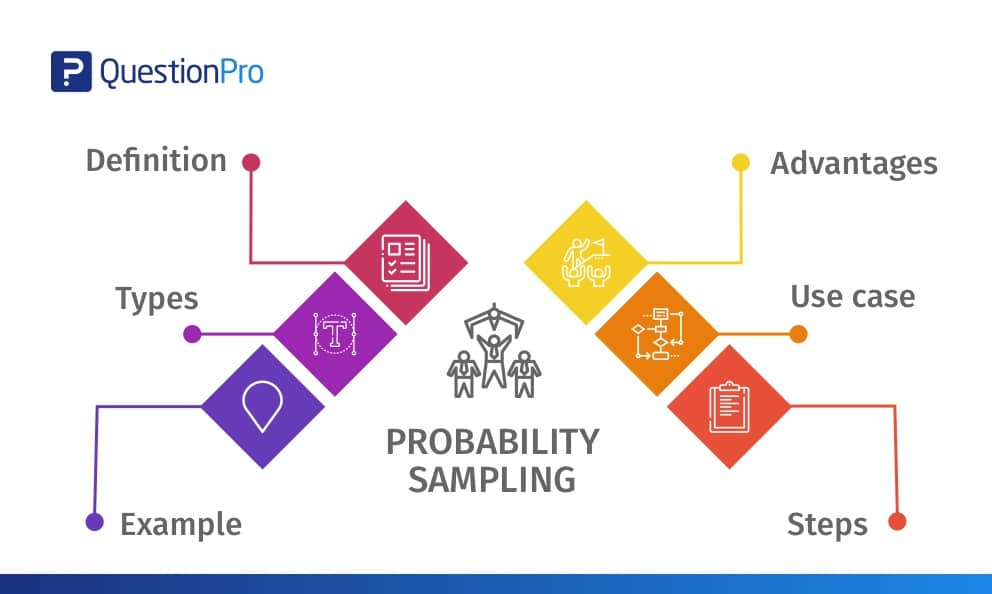
Imagine you have a population of 100 people. In this scenario, every person would have odds of 1 in 100 for getting selected. Probability sampling gives you the best chance to create a sample representative of the population. From the responses received, management will now know whether employees in that organization are happy about the amendment.
This sampling allows for unbiased and representative conclusions to be drawn about the population based on the sample. Let’s talk about probability sampling.
What is Probability Sampling?
Probability sampling is a technique in which the researcher chooses samples from a larger population using a method based on probability theory. For a participant to be considered as a probability sample, he/she must be selected using a random selection.
This statistical method used to select a sample from a population in such a way that each member of the population has a known, non-zero chance of being selected. The most critical requirement of probability sampling is that everyone in your population has a known and equal chance of getting selected.
Probability sampling uses statistical theory to randomly select a small group of people (sample) from an existing large population and then predict that all their responses will match the overall population.
LEARN ABOUT: Theoretical Research
What are the Types of Probability Sampling?
Selecting the right sample is crucial for obtaining accurate and reliable results. One of the most popular and effective methods for selecting a sample is probability sampling. Let’s explore the different types of probability sampling. From simple random sampling to stratified random sampling, we’ll break down each method to help you determine which one is best for your research project.
Here are some of the most effective types of probability sampling:
- Simple Random Sampling: This method involves randomly selecting a sample from the population without any bias. It’s the most basic and straightforward form of probability sampling.
- Stratified random Sampling: This method involves dividing the population into subgroups or strata and selecting a random sample from each stratum. This technique is useful when the population is heterogeneous and you want to ensure that the sample is representative of different subgroups.
- Cluster Sampling: This method involves dividing the population into groups or clusters and then randomly selecting some of those clusters. This technique is useful when the population is spread out over a large geographical area. But It is not possible or practical to survey everyone.
- Systematic Sampling: This method involves selecting every nth member of the population after a random starting point is chosen.
Probability sampling is widely used in research. It ensures that the sample is representative of the population, allows researchers to estimate the level of uncertainty in the results, and makes it possible to generalize the findings to the population.
1. Simple Random Sampling
As the name suggests, simple random sampling is an entirely random method of selecting the sample. This sampling method is as easy as assigning numbers to the individuals (sample) and then randomly choosing from those numbers through an automated process. Finally, the numbers that are chosen are the members that are included in the sample.
There are two ways in which researchers choose the samples in this method of sampling: The lottery system and using number-generating software/ random number table. This sampling technique usually works around a large population and has its fair share of advantages and disadvantages.
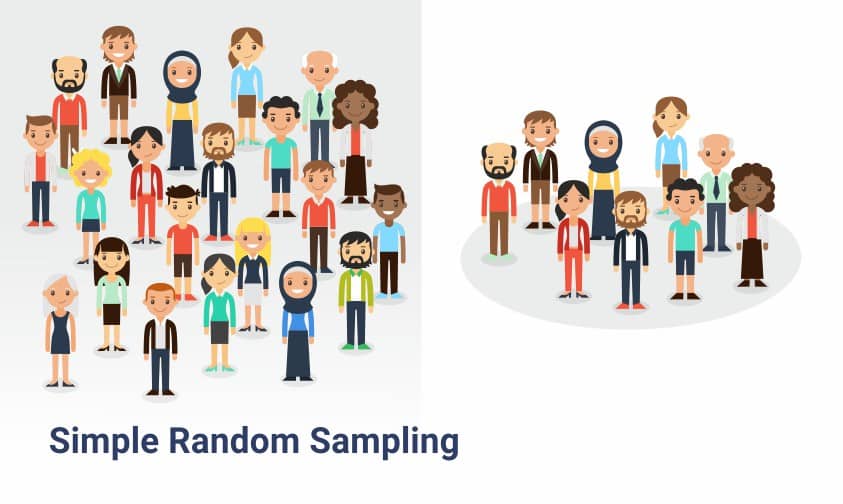
2. Stratified Random Sampling
Stratified random sampling involves a method where the researcher divides a more extensive population into smaller groups that usually don’t overlap but represent the entire population. While sampling, organize these groups and then draw a sample from each group separately.
A standard method is to arrange or classify by sex, age, ethnicity, and similar ways. Splitting subjects into mutually exclusive groups and then using simple random sampling to choose members from groups.
Members of these groups should be distinct so that every member of all groups get equal opportunity to be selected using simple probability. This sampling method is also called “random quota sampling.”

3. Cluster Sampling
Cluster sampling is a way to select participants randomly that are spread out geographically. For example, if you wanted to choose 100 participants from the entire population of the U.S., it is likely impossible to get a complete list of everyone. Instead, the researcher randomly selects areas (i.e., cities or counties) and randomly selects from within those boundaries.
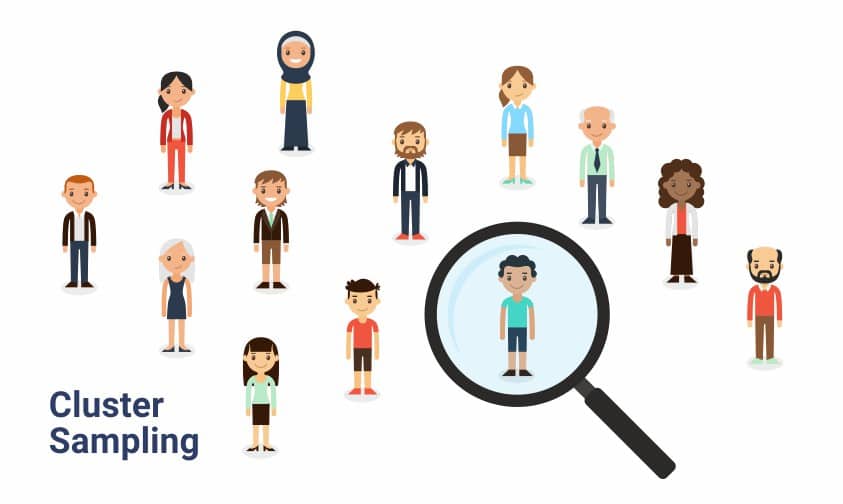
Cluster sampling usually analyzes a particular population in which the sample consists of more than a few elements, for example, city, family, university, etc. Researchers then select the clusters by dividing the population into various smaller sections.
4. Systematic Sampling
Systematic sampling is when you choose every “nth” individual to be a part of the sample. For example, you can select every 5th person to be in the sample. Systematic sampling is an extended implementation of the same old technique in which each group member is selected at regular periods to form a sample. There’s an equal opportunity for every member of a population to be selected using this sampling technique.

Whether you’re conducting a survey, a poll, or a study, understanding the different types of probability sampling can help you make informed decisions and achieve your research goals.
LEARN MORE: Population vs Sample
Probability Sampling Examples
Let us take an example to understand this sampling technique. The population of the US alone is 330 million. It is practically impossible to send a survey to every individual to gather information. Use probability sampling to collect data, even if you collect it from a smaller population.
For example, an organization has 500,000 employees sitting at different geographic locations. The organization wishes to make certain amendments in its human resource policy, but before they roll out the change, they want to know if the employees will be happy with the change or not. However, reaching out to all 500,000 employees is a tedious task. This is where probability sampling comes in handy. A sample from a larger population i.e., from 500,000 employees, is chosen. This sample will represent the population. Deploy a survey now to the sample.
LEARN ABOUT: Survey Sampling
From the responses received, management will now be able to know whether employees in that organization are happy or not about the amendment.
Probability Sampling Steps
Here are some practical steps you can follow to conduct:
- Choose your population of interest carefully: Carefully think and choose from the population of people you believe whose opinions should be collected. Then include them in the sample.
- Determine a suitable sample frame: Your frame should consist of a sample from your population of interest and no one from outside to collect accurate data.
- Select your sample and start your survey: It can sometimes be challenging to find the proper sample and determine a suitable sample frame. Even if all factors are in your favor, there may be unforeseen issues like the cost factors, quality of respondents, and quickness to respond. Getting a sample to respond accurately to a probability survey might be difficult, but possible.
But, in most cases, drawing a probability sample will save you time, money, and a lot of frustration. You probably can’t send surveys to everyone, but you can always give everyone a chance to participate. This is what a probability sample is all about.
When to use Probability Sampling?
Use probability sampling in these instances:
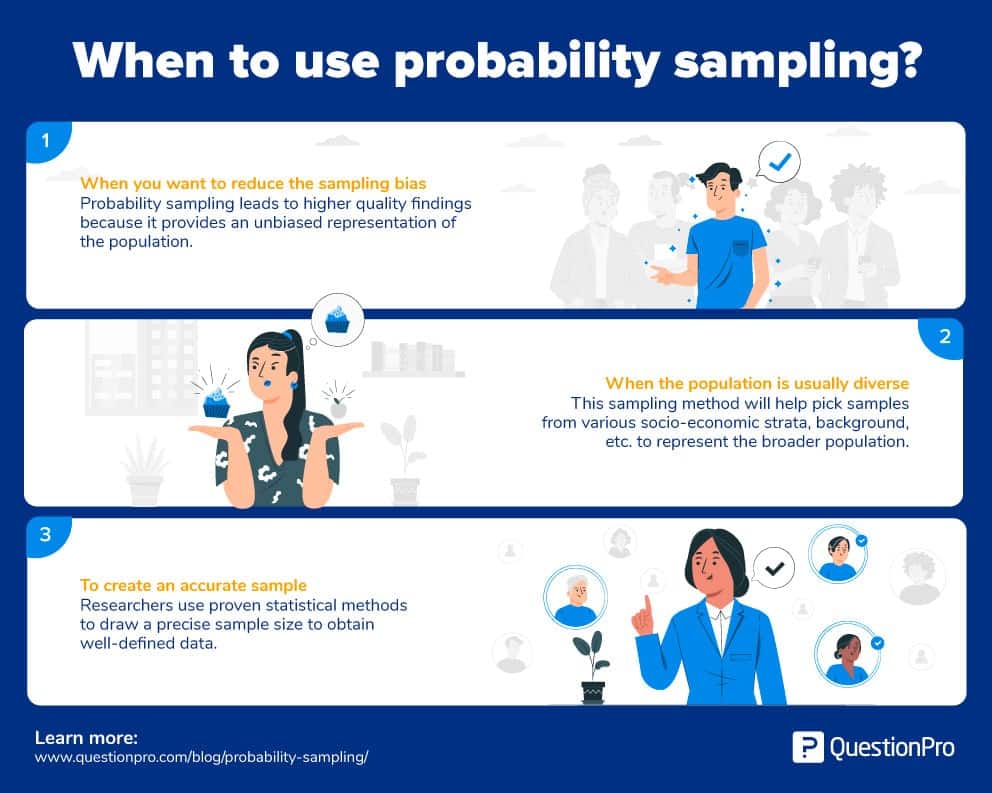
1. When you want to reduce the sampling bias: This sampling method is used when the bias has to be minimum. The sample selection largely determines the quality of the research’s inference. How researchers select their sample largely determines the quality of a researcher’s findings. Probability sampling leads to higher-quality findings because it provides an unbiased population representation.
2. When the population is usually diverse: Researchers use this method extensively as it helps them create samples that fully represent the population. Say we want to find out how many people prefer medical tourism over getting treated in their own country. This sampling method will help pick samples from various socio-economic strata, backgrounds, etc., representing the broader population.
3. To create an accurate sample: Probability sampling help researchers create accurate samples of their population. Researchers use proven statistical methods to draw a precise sample size to obtain well-defined data.
Advantages of probability sampling
Here are the advantages of probability sampling:
1. It’s Cost-effective: This process is cost and time effective. A larger sample can also be chosen based on numbers assigned to the samples. Then you can choose random numbers from the more significant sample.
2. It’s simple and straightforward: Probability sampling is an easy way as it does not involve a complicated process. It’s quick and saves time. The time saved can thus be used to analyze the data and draw conclusions.
3. It is non-technical: This sampling method doesn’t require any technical knowledge because of its simplicity. It doesn’t require intricate expertise and is not at all lengthy. You can also avoid sampling errors.
What is the difference between probability and non-probability sampling?
Here’s how you differentiate probability sampling from non-probability sampling,
|
Probability sampling |
Non-probability sampling |
|---|---|
| The samples are randomly selected. | Samples are selected on the basis of the researcher’s subjective judgment. |
| Everyone in the population has an equal chance of getting selected. | Not everyone has an equal chance to participate. |
| Researchers use this technique when they want to keep a tab on sampling bias. | Sampling bias is not a concern for the researcher. |
| Useful in an environment having a diverse population. | Useful in an environment that shares similar traits. |
| Used when the researcher wants to create accurate samples. | This method does not help in representing the population accurately. |
| Finding the correct audience is complex. | Finding an audience is very simple. |
Conclusion
Probability sampling is a valuable tool in statistical analysis that ensures a representative sample is selected from a larger population. QuestionPro’s robust suite of research tools provides you with all you need to derive research results. Our online survey platform includes custom point-and-click logic and advanced question types.
LEARN ABOUT: Statistical Analysis Methods
Co-create with your online communities and collect qualitative and quantitative insights for your continuous discovery process. Choose from over 22 million+ mobile-ready respondents to conduct ongoing market research studies.
Survey respondents for all your research needs
Access more than 10 specialty audiences, including veterinarians, app developers, building contractors, gamers, small-biz owners, and more.






